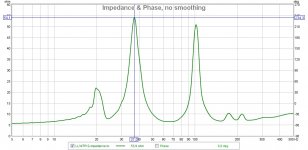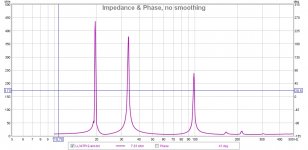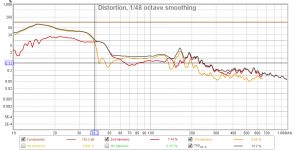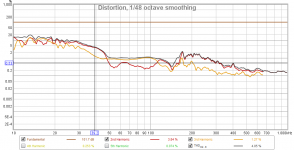Looking at the processed response I have a hard time imagening the above passband distortion components would be noticable once the design is properly integrated with a top system.
The THD measured in that graph may not be representative of what might be expected at the SPL levels that the system will normally be played back at.
I do my THD tests up to at least 10% level in the passband to get an idea of what sort of peak level I can expect before distortion may become too noticeable. You may find that other distortion components end up showing up in the passband, or the level of the distortion peaks changes non-linearly as SPL output is increased.
For comparison purposes, see attached the distortion profiles for my redesigned Enigma 4th order BP (passband = ~38 Hz to 115 Hz -3dB). The first one shows what the THD profile looks like at the 10% within passband limit, and the other at -12 dB below this. Note how the shape of the 2nd order and 3rd order HD curves within the passband are different between the two measurements.
FWIW, I actually used the distortion profile for the 10%THD graph to help set the HP filter for this particular subwoofer -basically cut the input by 6dB at 30 Hz with a 24dB/octave filter, because most of the distortion generated below 40 Hz was due to driver excursion.
Attachments
Good example Brian, thank you, and you also bring up a good point, namely that the intended purpose of a design (for instance SPL) defines a lot of what compromises can be made, and there are always compromises, who ever tells us differently may not understand that designing a loudspeaker is a compromise balancing act.
I may have come across a bit stubborn regarding the above pass band distortion products, this was not my intention, I realize there might be issues, and I do care about what issues there might be, but I have also noted that most times problems appear greater on paper then in reality, and reality is what goes, that was the message I wanted convey.
I also believe (from experience) that often (not always) once the processing is applied correctly and the integration with a top system is taken care of one might find that the issue that initially looked quite severe in simulations simply is no longer that severe of an issue, BUT... there are also those fairly rare times when it is, this is why I wanted to see what the case might be here, but you are right to point out the risk.
What I would like to have is the possibility to do is a constant THD measurement, for 1, 3 and 10% distortion, and look at the SPL response granted for each case, this would let you know the capabilities of a design and how to process it correctly, as far as I know only klippel offer this, not sure about REW.
I may have come across a bit stubborn regarding the above pass band distortion products, this was not my intention, I realize there might be issues, and I do care about what issues there might be, but I have also noted that most times problems appear greater on paper then in reality, and reality is what goes, that was the message I wanted convey.
I also believe (from experience) that often (not always) once the processing is applied correctly and the integration with a top system is taken care of one might find that the issue that initially looked quite severe in simulations simply is no longer that severe of an issue, BUT... there are also those fairly rare times when it is, this is why I wanted to see what the case might be here, but you are right to point out the risk.
What I would like to have is the possibility to do is a constant THD measurement, for 1, 3 and 10% distortion, and look at the SPL response granted for each case, this would let you know the capabilities of a design and how to process it correctly, as far as I know only klippel offer this, not sure about REW.
What I would like to have is the possibility to do is a constant THD measurement, for 1, 3 and 10% distortion, and look at the SPL response granted for each case, this would let you know the capabilities of a design and how to process it correctly, as far as I know only klippel offer this, not sure about REW.
I've found that the testing method I use gives me both the best idea of a system's linear output capability.
In that case of that particular bandpass design, I was told again and again that it would not be suitable for where and how it was going to be used. Well, it's been in use for several months without an issue and the current owner is very happy with the results
Rebuilding the Enigma...
Of course sine sweeps don't give an idea of if the driver's soft parts are going to suffer from any sort of fatigue under long use (it gets about 10~12 hours of play every day at fairly high levels), so in a few months I'm going to retrieve the subwoofer from the bar and check it out to see if there's anything to worry about in that regard.
I am in the slow process of evaluating and learning how to best use this TP12LL34.
It is a fun and very useful HT-sub!


I am running it from a single channel from my JBL Stage A6002 amp, and it does not give more then 25 - 30 watts into 8 ohms.
It does tend to sound very nice playing Charlie Hadens record Heartplay or Camille Thurmans record Inside the Moment, adding a great presence and a very believable sense of scale and texture to double bass and drums.
I have a lot of work left to properly integrate it into a great sounding setup, but despite my lack of experience with this kind of strange beast, I am making a lot of progress and I hear that there is a lot of potential.
It is a fun and very useful HT-sub!
I am running it from a single channel from my JBL Stage A6002 amp, and it does not give more then 25 - 30 watts into 8 ohms.
It does tend to sound very nice playing Charlie Hadens record Heartplay or Camille Thurmans record Inside the Moment, adding a great presence and a very believable sense of scale and texture to double bass and drums.
I have a lot of work left to properly integrate it into a great sounding setup, but despite my lack of experience with this kind of strange beast, I am making a lot of progress and I hear that there is a lot of potential.
And more modern strange modulated electronic complex bass like in the song Glish from Deadmau5 and the song Giants from Trentemøller tends to sound very large, present in the room and with a great tactile sense of scale. The bass is very "there" without any physical effort or bloated resonant overshoot. It seems very exact and precise with a large physical and tactile presence.
I am waiting for better weather so I can measure it outdoors at higher power levels.
I am waiting for better weather so I can measure it outdoors at higher power levels.
Thats good news, thanks for sharing, I found that it takes some time to figure out new designs, to get to know them so to speak.
Intresting performance description considering that it is a rather compact enclosure and that the 12ps100 although being a very nice woofer is not extreme in any way, so what you have there is a easy to build rather compact design given its range and one that does not require anything very special in terms of woofer, good job!
Intresting performance description considering that it is a rather compact enclosure and that the 12ps100 although being a very nice woofer is not extreme in any way, so what you have there is a easy to build rather compact design given its range and one that does not require anything very special in terms of woofer, good job!
How about adding a Helmholtz-resonator designed to create a suck-out around 200 Hz? Would probably reduce the aforementioned distortion and the need for a very steep LP-filter.Here are some first measurements of this little beast.
I have overlaid the raw response with the as-used response with EQ and Xover using my MiniDSP 2X4HD. All the measurements are taken indoors with an Umik microphone and REW. Microphone 5 cm from the port on one side of the box (there are two ports. One on each side). No smoothing. The distortion graph has some small peaks where it does indeed get close to a single percent THD, but overall the THD is centered around the 0,5 percent level for most of the passband.
When scanning though the passband in the distortion graph it is very clear that the distortion is highest in the lower part of the passband where there is no acoustic positive feedback. From 50 Hz and upwards the positive feedback makes the driver behave like it had a lot more Bl and moving mass - a much more powerful driver.
I measured from 10 Hz to 500 Hz in order to get a decent amount of the out of passband ripple and distortion. The ripple peaks 6,3 dB (not quite 15 dB) above the peak of the passband. I guess there are other ways of weighting this kind of comparison but I just took the most obvious example first. I am sure someone will tell me a better way more to your liking if anyone wants it.
Easy to test, just make a hole in the box and add a port coupled to a small volume. Test different ports and amounts of polyfill in the external box until desired behavior is obtained. I'm guessing that the port should be close to the driver for maximum efficiency.
/Anton

Actual measurement.

Hornresp sim.
Here is an impedance measurement made with a Dayton DATS v2.
The impedance peak at 20 Hz is surprisingly low compared with the two others.
All three major peaks are quite a bit lower the the Hornresp simulation, but the 20 Hz peak is by far the highest one in the simulated graph, while it is the lowest one in the measured on.
Is this from the lack of stiffness in the 22 mm particle board walls of the enclosure?
The lowest peak will always be somewhat noticeably off from the sim because of the model that Hornresp uses. Basically some additional parameters are need for the driver, and these are not usually provided. Look up "Frequency dependent damping". All of the measured peaks will be lower than what the sim suggests they should be because the Hornresp model does not include losses.
If the frequency of the other peaks is significantly off from the Hornresp sim, then that means that the sim does not accurately describe what was built. This happened with my first TH build, and the likely cause was that my estimates for path length in the TH were slightly off.
If the frequency of the other peaks is significantly off from the Hornresp sim, then that means that the sim does not accurately describe what was built. This happened with my first TH build, and the likely cause was that my estimates for path length in the TH were slightly off.
- Home
- Loudspeakers
- Subwoofers
- TP12LL34 Duality and positive feedback

